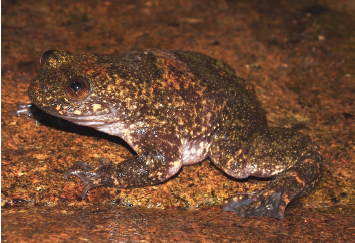Research uncovers new information on the voice of the Philippine flat-headed frog found only in Palawan
07 Mar 2025

This study describes the call of Barbourula busuangensis, a peculiar and elusive fully aquatic frog endemic to the Palawan archipelago of western Philippines. Although the frog is quite popular among herpetologists in the Philippines, this species is still poorly known that most of its basic natural history characteristics (reproductive mode and seasonality, diet, age structure, lifespan) remain to be discovered. Although our team has done recent field studies, the field data still waits to be organized and analyzed. This report is the first close-up study that we have done so far. Contrary to the calls of other frog species adapted to life in fast-flowing streams, the call of B. busuangensis is not heard ordinarily because it has a very low fundamental frequency around 250Hz with an average duration of 1.2 seconds. The voice recording had to be done using special monodirectional microphone that can detect low sound frequencies. Additionally, its pulsed, amplitude modulated structure differs from the calls of known species in its most closely-related (sister) clade, the genus Bombina.
This research is novel since it provides new information on sound/voice of the Barbourula busuangensis which is an endemic species found only in Palawan. Since there are only two Barbourula species in the whole world, this Palawan endemic frog is of high global value in science and conservation. This article is the first and closest information on its biology. Although we have been engaged in current research on other aspects of its biology such as home range, reproductive mode and seasonality, diet, age structure, lifespan etc. our data are still in the process of analysis. We are excited to share this initial result and are working toward sharing more information for a better understanding of its biology and generating more appropriate approaches to its conservation.
Authors:
Jaime Bosch (IMIB-Biodiversity Research Institute (IMIB, CSIC/University of Oviedo/Principality of Asturias), Gonzalo Gutiérrez Quirós s/n, Edificio de Investigación), Leticia Afuang (Animal Biology Division, University of the Philippines Los Baños), Marta Miñarro (Museo Nacional de Ciencias Naturales-CSIC), Claudia Lansac (Museo Nacional de Ciencias Naturales-CSIC), Rafael Márquez (Museo Nacional de Ciencias Naturales-CSIC), Rafe Brown (Herpetology Division, KU Biodiversity Institute, Dyche Hall, University of Kansas), Aurora V. Lacaste (Faculty of Education, University of the Philippines Open University), Patricia A. Burrowes (Museo Nacional de Ciencias Naturales-CSIC | Department of Biology, University of Puerto Rico) and Ignacio De la Riva (Museo Nacional de Ciencias Naturales-CSIC)
Read the full paper: https://www.salamandra-journal.com/
Photo by Ignacio dela Riva
